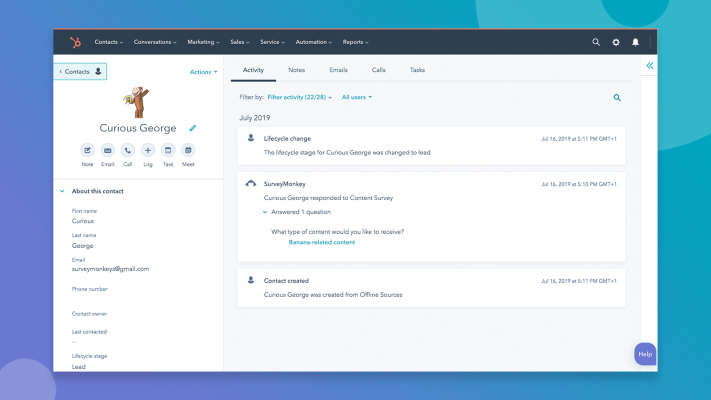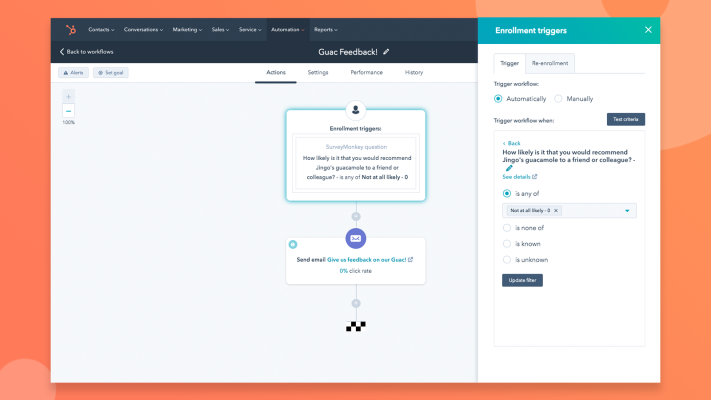Whether you truly understand your customers can make or break your business growth. Surveys remain one of the best ways to understand exactly what your customers expect from your business so you can take action to drive engagement and retention.
For example, in this year’s State of Marketing report from HubSpot, 94% of marketers said that personalization boosts sales. And while good personalized marketing requires that you collect data on your customers, chances are that they almost universally want more privacy—not less. So how do you give your customers better, more personalized experiences while respecting their privacy?
By sending them surveys to directly provide their thoughts, opinions, and preferences so you can build trust in your brand AND provide the benefits of a more individualized experience. That’s why over 10,000 companies have added the SurveyMonkey app for HubSpot to their service tech stack to improve customer experience.
Why actionable survey data helps improve customer experience
When customer-facing teams have easy access to real-time customer and prospect feedback, it allows them to take immediate action to improve their processes. These iterative changes can increase client satisfaction and remove friction from marketing, sales, and service workflows.
Here’s what easy access to customer feedback data and automation allows you to do:
- Monitor sentiment and address trends and issues surfaced in survey data
- Segment email lists and create automated workflows based on survey responses
- Trigger follow-ups for satisfaction surveys and alert account managers with critical or time-sensitive feedback
- Use smart content like CTAs and active lists to only send survey respondents the information they want
- Bring valuable context gleaned from surveys to sales conversations
- Use survey information as scoring criteria to prioritize event follow-up
The best part is that our users are still finding new and creative ways to work better by using SurveyMonkey and HubSpot together. Just take this review on G2 for example:
“SurveyMonkey has useful scoring features which has allowed my company to generate internal skills assessments to track employee domain knowledge. In the past, we had to create Google Forms, gather responses and manually score each response to rate each sales employee. With SurveyMonkey, this process is automated. What's better is that SurveyMonkey integrates with our HubSpot CRM,” Samuel L. shared on G2.
3 ways to use SurveyMonkey with HubSpot to improve customer experiences
While customer feedback surveys are powerful, they’re only useful if everyone has access to the insights. If the responses end up in a siloed location where only the customer service teams can use them, the value of soliciting that information is wasted. Truly great customer feedback programs use organized workflows to route feedback to the right teams so that the entire organization benefits. Here are few ways to make sure you’re enabling all teams with your survey insights by using the SurveyMonkey integration with HubSpot:
1. Automatically send surveys to HubSpot contacts after sales milestones
Enable your sales team with better insights from your customer surveys. Get more detailed, actionable responses by seamlessly combining feedback data with account and lead records in HubSpot.

2. Share case-closed surveys to measure customer support satisfaction
Sending automated case-closed surveys can free up customer service teams to handle more complex challenges. The feedback you receive can help you proactively identify areas of improvement and assess the bigger picture of how customers interact with your team. With these learnings, it’s easier to zero in on and address any gaps in training, automation, or process that could be improved.
With this data, you can also identify potential areas of customer loyalty and lower costs of service.

3. Build tailored marketing campaigns by enriching HubSpot contacts with feedback data
Your survey data can be the starting point for creating custom segments in your HubSpot contact database. For example, surveys that identify your happiest customers can be the starting point for turning them into brand advocates to enrich your marketing campaigns. Plus, you can use customer feedback to build better, more strategic marketing campaigns that convert customers as they move through their journey with your brand.

Explore more ways to use connected survey feedback workflows for customer success
There are countless ways to apply SurveyMonkey data to the work your customer, marketing, and sales team do on the HubSpot platform.
For example, Sara, a content strategist at an enterprise org, uses SurveyMonkey with HubSpot to easily onboard new customers. “I appreciate how intuitive their product has become—you can jump in and get started. We link SurveyMonkey to HubSpot for onboarding new customers while we build out a custom tool, and it’s a great option.”
Interested to learn more? See how the SurveyMonkey app for HubSpot can serve as an all-in-one customer feedback tool to guide business growth, and take a look at all of HubSpot’s Essential Apps for Customer Service.



